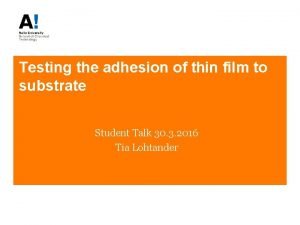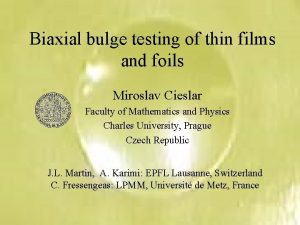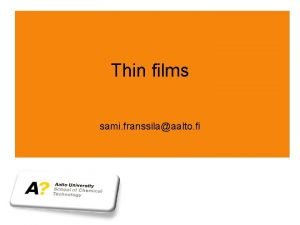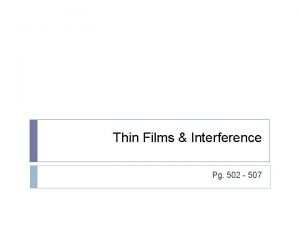Magnetic Thin Films and Devices NSF CAREER AWARD



- Slides: 3

Magnetic Thin Films and Devices: NSF CAREER AWARD Task 1: Surface Morphology and Magnetic Structure R. D. Gomez, University of Maryland, College Park, MD GOAL: To correlate microstructure and magnetic properties of Co on Si(100) as a function of thickness. APPROACH: A UHV-system with deposition and in-situ scanned probe microscope capability is used to make cobalt arrays with thickness gradient at the pattern edges. A novel in-situ shadow mask is developed. ACCOMPLISHMENTS: • First atomically-resolved systematic correlation of grain-size and thickness. • First UHV-MFM observations of domain boundaries at edge PUBLICATIONS: • UHV MFM/STM study of in situ structured Cobalt films on Si(001), M. Dreyer and R. D. Gomez, Joint MMM/Intermag 2001 Conference, submitted.

Magnetic Thin Films and Devices: NSF CAREER AWARD Task 2: Spin Polarized Tunneling Microscopy R. D. Gomez, University of Maryland, College Park, MD GOAL: To develop a spin-dependent scanning tunneling microscope (STM) to investigate magnetic domains of spin polarized samples. APPROACH: Use standard STM with special Cr. O 2 coated tip, on 200 nm perpendicularly magnetized Ni. Fe (permalloy) sample. Cr. O 2 is 100% spin polarized, Permalloy is 30%. Correlate with magnetic structure obtained using magnetic force microscope (MFM). DIGRESSION: CONTRAST FORMATION In general, tunneling current density is a product of density of occupied and unoccupied states of the tip and sample: If tip and sample are polarized: Or, MILESTONE: Successful coating of STM tip, using high temp Cr. O 3 decomposition on O 2 reactor chamber. ACCOMPLISHMENT: Successful imaging of domains in permalloy using Cr. O 2 tip, possibly first observation of domains of Ni. Fe using spin polarized probe. STM with Cr. O 3 tip, magnetic contrast AFM, sample texture MFM, magnetic domains PUBLICATION: Development of Spin Polarized Scanning Tunneling Microscopy for Magnetic Domain Imaging, J. Flory, M. Dreyer, W. Egelhoff, T. Egelhoff and R. D. Gomez, in prep.

Magnetic Thin Films and Devices: NSF CAREER AWARD Task 3: Patterned Sub-micron Structures R. D. Gomez, University of Maryland, College Park, MD GOAL: To understand the domain configuration and switching characteristics of epitaxially grown Cobalt/Mg. O. APPROACH: Use MFM in the presence of applied external field on patterned films fabricated at Stanford University by Prof. R. L. White and S. Ganesan. RESULTS: • MFM images show exclusive domain configuration with shape and crystal anisotropy easy axes are parallel (S 1). • MFM images show single and bidomain stable configurations when shape and crystal anisotropy axes are orthogonal (S 2). • For S 1, Hc ~ 2500 Oe, single domain reversal. • For S 2, Hc ~ 1800 Oe, reversal via single and intermediate bidomain states.





